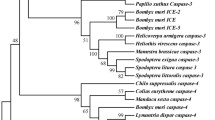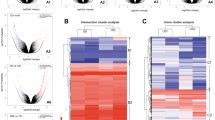Abstract
The cell lines provided excellent tools to understand the mechanism of biological phenomenon at the cellular and molecular levels. The continuous development of new cell culture technology is both of interest for use in biochemical, immunology, and virological studies. The transformation of cells of the primary culture is a key procedure for insect cell line establishment but little is known about the molecular basis of these changes. Here, we found that the cell cycle progression of the cells of the primary culture was delayed or arrested in G2/M by fluorescence-activated cell sorting analysis. In this study, two subtractive cDNA libraries were constructed to screen for immortal-related genes of Spodoptera exigua (Lepidoptera: Noctuidae). Gene ontology and pathway analysis indicated that members of the oxidative phosphorylation, PI3K-Akt signaling pathway, and the ubiquitin proteasome pathway are involved in processes leading toward cell immortalization merit further investigation. Our findings suggest that tumor-related genes or target genes of these pathways may contribute to the transformation of primary cell through regulation of G2/M cell cycle progression.






Similar content being viewed by others
References
Balint EE, Vousden KH (2001) Activation and activities of the p53 tumour suppressor protein. Br J Cancer 85:1813–1823
Brodsky MH, Weinert BT, Tsang G, Rong YS, McGinnis NM, Golic KG, Rio DC, Rubin GM (2004) Drosophila melanogaster MNK/Chk2 and p53 regulate multiple DNA repair and apoptotic pathways following DNA damage. Mol Cell Biol 24(3):1219–1231
Bromfield GP, Meng A, Warde P, Bristow RG (2003) Cell death in irradiated prostate epithelial cells: role of apoptotic and clonogenic cell kill. Prostate Cancer Prostatic Dis 6:73–85
Cherbas L, Willingham A, Zhang D, Yang L, Zou Y, Eads BD, Carlson JW, Landolin JM, Kapranov P, Dumais J, Samsonova A, Choi JH, Roberts J, Davis CA, Tang H, van Baren MJ, Ghosh S, Dobin A, Bell K, Lin W, Langton L, Duff MO, Tenney AE, Zaleski C, Michael BR, Hoskins RA, Kaufman TC, Andrews J, Graveley BR, Perrimon N, Celniker SE, Gingeras TR, Cherbas P (2011) The transcriptional diversity of 25 Drosophila cell lines. Genome Res 21:301–314
Deckbar D, Jeggo PA, Löbrich M (2011) Understanding the limitations of radiation-induced cell cycle checkpoints. Crit Rev Biochem Mol Biol 46(4):271–283
Diatchenko L, Lau YFC, Campbell AP, Chenchik A, Moqadam F, Huang B (1996) Suppression subtractive hybridization: a method for generating differentially regulated or tissue-specific cDNA probes and libraries. Proc Natl Acad Sci USA 93:6025–6030
Fang Q, Wang L, Zhu JY, Li YM, Song QS, Stanley DW, Akhtar ZR, Ye GY (2010) Expression of immune-response genes in lepidopteran host is suppressed by venom from an endoparasitoid, Pteromalus puparum. BMC Genomics 11:484
Flatt PM, Price JO, Shaw A, Pietenpol JA (1998) Differential cell cycle checkpoint response in normal human keratinocytes and fibroblasts. Cell Growth Differ 9:535–543
Girinsky T, Koumenis C, Graeber TG, Peehl DM, Giaccia AJ (1995) Attenuated response of p53 and p21 in primary cultures of human prostatic epithelial cells exposed to DNA-damaging agents. Cancer Res 55:3726–3731
Granados RR, Li GX, Derksen ACG, Mckenna KA (1994) A new insect cell line from Trichoplusia ni (BTI-Tn-5B1-4) susceptible to Trichoplusia ni single enveloped nuclear polyhedrosis virus. J Invertebr Pathol 64:260–266
Greenberg SM, Sappington TW, Legaspi BC, Liu TX, Setamou M (2001) Feeding and life history of Spodoptera exigua (Lepidoptera: Noctuidae) on different host plants. Ann Entomol Soc Am 94(4):566–575
Huang N, Clem RJ, Rohrmann GF (2011) Characterization of cDNAs encoding p53 of Bombyx mori and Spodoptera frugiperda. Insect Biochem Mol Biol 41:613–619
Irles P, Bellés X, Piulachs MD (2009) Identifying genes related to choriogenesis in insect panoistic ovaries by suppression subtractive hybridization. BMC Genomics 10:206
Iwabuchi K (2000) A continuous cell line derived from larval fat bodies of Thysanoplusia intermixta (Lepidoptera: Noctuidae). Appl Entomol Zool 35:245–249
Lehane MJ, Gibson W, Lehane SM (2008) Differential expression of fat body genes in Glossina morsitans morsitans following infection with Trypanosoma brucei brucei. Int J Parasitol 38:93–101
Lew-Tabor AE, Moolhuijzen PM, Vance ME, Kurscheid S, Valle MR, Jarrett S, Minchin CM, Jackson LA, Jonsson NN, Bellgard MI, Guerrero FD (2010) Suppressive subtractive hybridization analysis of Rhipicephalus (Boophilus) microplus larval and adult transcript expression during attachment and feeding. Vet Parasitol 167:304–320
Li X, Qin QL, Zhang N, Zhu W, Zhang JH, Wang HT, Miao L, Zhang H (2012) A new insect cell line from pupal ovary of Spodoptera exigua established by stimulation with N-methyl-N ’-nitro-N-nitrosoguanidine (MNNG). In Vitro Cell Dev Biol Anim 48:271–275
Lynn DE (2001) Novel techniques to establish new insect cell lines. In Vitro Cell Dev Biol Anim 37:319–321
Melchior F (2000) SUMO–nonclassical ubiquitin. Annu Rev Cell Dev Biol 16:591–626
Meyer KM, Hess SM, Tlsty TD, Leadon SA (1999) Human mammary epithelial cells exhibit a differential p53-mediated response following exposure to ionizing radiation or UV light. Oncogene 18:5795–5805
Mitsuhashi J (1981) Establishment and some characteristics of a continuous cell line derived from fat bodies of the cabbage armyworm (Lepidoptera, Noctuidae). Develop Growth and Differ 23:63–72
Muller D, Millon R, Théobald S, Hussenet T, Wasylyk B, du Manoir S, Abecassis J (2006) Cyclin L1 (CCNL1) gene alterations in human head and neck squamous cell carcinoma. Br J Cancer 94:1041–1044
Ng SSW, Tsao MS, Chow S, Hedley DW (2000) Inhibition of phosphatidylinositide 3-kinase enhances gemcitabine-induced apoptosis in human pancreatic cancer cells. Cancer Res 60:5451–5455
Ogata N, Yokoyama T, Iwabuchi K (2012) Transcriptome responses of insect fat body cells to tissue culture environment. PLoS ONE 7(4):e34940
Reid Y, Gaddipati JP, Yadav D, Kantor J (2009) Establishment of a human neonatal hepatocyte cell line. In Vitro Cell Dev Biol Anim 45:535–542
Rinehart JP, Li A, Yocum GD, Robich RM, Hayward SA, Denlinger DL (2007) Up- regulation of heat shock proteins is essential for cold survival during insect diapause. Proc Natl Acad Sci USA 104(27):11130–11137
Rodriguez MS, Desterro JMP, Lain S, Midgley CA, Lane DP, Hay RT (1999) SUMO-1 modification activates the transcriptional response of p53. EMBO J 18:6455–6461
Simcox A, Mitra S, Truesdell S, Paul L, Chen T, Butchar JP, Justiniano S (2008) Efficient genetic method for establishing Drosophila cell lines unlocks the potential to create lines of specific genotypes. PLoS Genet 4:e1000142–e1000142
Smagghe G, Goodman CL, Stanley D (2009) Insect cell culture and applications to research and pest management. In Vitro Cell Dev Biol Anim 45(3–4):93
Tu Y, Chen C, Pan J, Xu J, Zhou ZG, Wang CY (2012) The ubiquitin proteasome pathway (UPP) in the regulation of cell cycle control and DNA damage repair and its implication in tumorigenesis. Int J Clin Exp Pathol 5(8):726–738
Xirodimas DP, Sundqvist A, Nakamura A, Shen L, Botting C, Hay RT (2008) Ribosomal proteins are targets for the NEDD8 pathway. EMBO Rep 9:280–286
Zhang AJ, Li X, Zhang H, Wang HT, Miao L, Zhang JH, Qin QL (2012) A new cell line from Spodoptera exigua (Lepidoptera: Noctuidae) and its differentially expressed genes. J Appl Entomol 136:632–637
Zhang H, Zhang YA, Qin QL, Li X, Miao L, Wang YZ, Qu LJ, Zhang AJ, Yang Q (2009) A cell strain cloned from Spodoptera exigua cell line (IOZCAS-Spex-II) highly susceptible to S exigua nucleopolyhedrovirus infection. In Vitro Cell Dev Biol Anim 45:201–204
Zhang H, Zhang YA, Qin QL, Li X, Miao L, Wang YZ, Yang ZQ, Ding C (2006) New cell lines from larval fat bodies of Spodoptera exigua: characterization and susceptibility to Baculoviruses (Lepidoptera: Noctuidae). J Invertebr Pathol 91:9–12
Zhang L, Rahbari R, He M, Kebebew E (2011) CDC23 regulates cancer cell phenotype and is overexpressed in papillary thyroid cancer. Endocr Relat Cancer 18(6):731–742
Acknowledgments
This research was jointly supported by The Scientists Fund of The National Natural Science Foundation of China (Grant No. 31272366), The Young Scientists Fund of The National Natural Science Foundation of China (Grant No. 30900947), and The State Key Laboratory of Integrated Management of Pest Insects and Rodents (Grant No. Chinese IPM1301).
Author information
Authors and Affiliations
Corresponding author
Additional information
Editor: T. Okamoto
Rights and permissions
About this article
Cite this article
Zhang, H., Meng, Q., Tang, P. et al. Gene expression pattern of insect fat body cells from in vitro challenge to cell line establishment. In Vitro Cell.Dev.Biol.-Animal 50, 952–972 (2014). https://doi.org/10.1007/s11626-014-9798-2
Received:
Accepted:
Published:
Issue Date:
DOI: https://doi.org/10.1007/s11626-014-9798-2




